A New Method for Fast Estimation of Collision Dissipated Energy and Its Application in Ship-Platform Collision Accident
GU Jia-yang,DENG Bing-lin,TAO Yan-wu,WANG Pu,ZHOU Jia
(1.Jiangsu University of Science and Technology,Zhenjiang 212003,China;2.Marine Design&Research Institute of China,Shanghai 200011,China)
A New Method for Fast Estimation of Collision Dissipated Energy and Its Application in Ship-Platform Collision Accident
GU Jia-yang1,DENG Bing-lin1,TAO Yan-wu1,WANG Pu2,ZHOU Jia2
(1.Jiangsu University of Science and Technology,Zhenjiang 212003,China;2.Marine Design&Research Institute of China,Shanghai 200011,China)
In the course of operation,the offshore platform has the potential risk of collision with ships.Once an accident occurs,it may cause serious damages to the structure of the platform and affect the safety of operation.Therefore,more attention should be paid to the crashworthiness of the offshore platform in the design stage.In this paper,collisions between an ocean supply ship and a semi-submersible drilling platform are studied.Based on the collision external dynamic theory and DNV specification calculation method,taking into account the influence of yawing motion response to platforms,a new dissipated energy estimation method,named DNV`R method,is proposed.Using the numerical simulation results of nonlinear finite element of ship-platform collision for reference,this analytic method is compared with the specification method,Zhang’s method and Liu’s method.The comparison shows that the DNV`R method fills the gap of the limitation of the specification method that is conservative and only applicable for central impact.The DNV`R method is simple and convenient.And its calculation results are close to those of Zhang’s method or those of Liu’s method,which meets the accuracy requirements of fast estimation of ship-platform collision dissipated energy.
ship-platform collision;dissipated energy;analytical method;external dynamics of collision
0 Introduction
The offshore platform has the potential risk of collision with ships in the course of operation.The resultant structural damage is likely to bring about economic losses,and may even cause serious consequences to people’s life and property and ecological environment,so it is necessary to consider the collision resistance of the platform against ship impacts in the earliest design stages of an platform structure.In terms of energy,the nature of the collision is theprocess of energy conversion:the strain energy generated by the platform structural damage derives from the energy dissipated by the impact ship,in other words,the magnitude of the strain energy due to a collision accident reflects the severity of the structural damage.Therefore,it is important to estimate the energy dissipated by the collision vessel accurately and quickly as it can provide important information for the crashworthiness design of the platform structure.
For collisions,it has strong nonlinear characteristic,and the collision process is accompanied by the large deformation of the structure and the coupling reaction of the fluid around the two sides.It is difficult to consider the above factors at the same time in the actual analysis.Wang’s[1]research shows that the collision process of ships can be split into collision external dynamics and internal dynamics,respectively.The former mainly analyzes the movement of the hull and the energy loss after the collision,and the latter analyzes the deformation resistance,deformation energy dissipation and structural damage of the collisional structure based on the theory of elastoplastic theory.
In the study of external dynamics,Minorsky[2]pioneered the method of estimating the kinetic energy dissipation in the ship collision.Petersen[3]analyzed the external mechanism of ship collision by time domain simulation.The hydrodynamic force of ship was calculated by slicing theory.It was assumed that the main body of the ship was rigid body and the deformation caused by collision mainly occurred on the contact surface,and the contact surface was simplified as a nonlinear spring.Woison[4]analyzed the energy loss of the ship collision and assumed that the collided ship was completely plastic,the hull surface was completely rough,and no relative slippage occurred on the collision contact surface.Besides,Zhang[5]developed an algorithm for the external mechanism of plane motion of ship-ship collision,which solved the energy dissipation and impulse change value in each direction by integrating the contact force and relative displacement in each direction.Based on Stronge’s work[6]that developed an advanced solution for 3D impacts,Liu[7]extended the method of Zhang’s[5]to three dimensions,developed a new formulation for the analysis of the impact mechanics of ship collision and applied the formula to the ship-iceberg impact field.Besides,Hu et al[8]analyzed the external dynamics of the ship-ship collision model,and proposed a method for determining the coefficient of conservative restitution.
In the internal dynamics study,McDermott et al[9]established a set of low-energy collision analysis methods for oil tankers.The method is based on a series of basic assumptions that include bending and buckling of stiffened plates,film stretching of outer panels and decks,and failure of frames.In addition,Hairs[10],Gao et al[11]and Liu[12-13]studied the damage deformation and failure of the components in the collision,and established the corresponding calculation model.
In recent years,some researchers have coupled the external dynamics and the internal dynamics collision analysis[14-15].Compared to the analysis of two individual processes,it includes more aspects and provides a relatively comprehensive revelation of the basic rules of the collision.However,the cost of coupling analysis is high,and independent external analysis and internal mechanism analysis are still efficient and the analytical results obtained are still within a certain permit range of analytical methods.
For the ship-platform collision,due to the relatively smaller probability of ship-bridge collision and ship-ship collision and the relatively low attention,it is studied mainly on the research theory of ship-ship collision and ship-bridge collision at present.The method of calculating the dissipated energy after the ship impact platform is divided into analytic method and numerical method,i.e.,finite element method.Based on the general theory of rigid body collision mechanics,the mathematical equation deduced by analytical method is simple,easy to apply and widely applicable.And the numerical method requires accurate mechanical models,including meshing,boundary condition and external force processing.Although the result is more accurate,it requires a lot of modeling and calculation cost input,and only applies to a specific mechanical model,which means the applicability is limited.
In this paper,collisions between an ocean supply ship and a semi-submersible drilling platform are studied.Based on the external dynamic theory of collision and DNV specification[16],the dynamic analysis of the ship-platform eccentric impact scenario is carried out.Considering the influence of yawing motion response to a platform,a new dissipative energy estimation method is developed,called DNV`R analytical method.Furthermore,a calculation example of collision scene with different impact velocity and different impact angle is carried out.Referring to the numerical simulation results of nonlinear finite element of ship-platform collision the result of DNV`R analysis method is compared to those of the standard method,Zhang’s[5]analysis method and Liu’s[7]analysis method.
1 Calculation of dissipated energy by DNV specification method
Based on the characteristics of energy conversion during ship-platform collision,DNV specification[16]proposed the energy dissipation experience of floating platform.When calculating the impact energy dissipation of the collision vessel,it is generally believed that the kinetic energy dissipated by the impact vessel is all transformed into the structural strain energy,and the collision platform reaches the common velocity.With the energy conservation equation and the momentum conservation equation of the collision system,the dissipated energy calculation formula can be obtained as follows:

where Edisiptis the dissipated energy of the striking ship,ms,miare the mass of the ship and platform,as,aiare the added mass of the ship and platform,and vs,viare the velocity before collision of the ship and platform.
In the operation process on the platform,it is generally considered that the speed of the platform before the collision is vi=0,then Eq.(1)can be reduced to:

2 The dissipated energy estimation method considering the influence of yawing motion response to platform
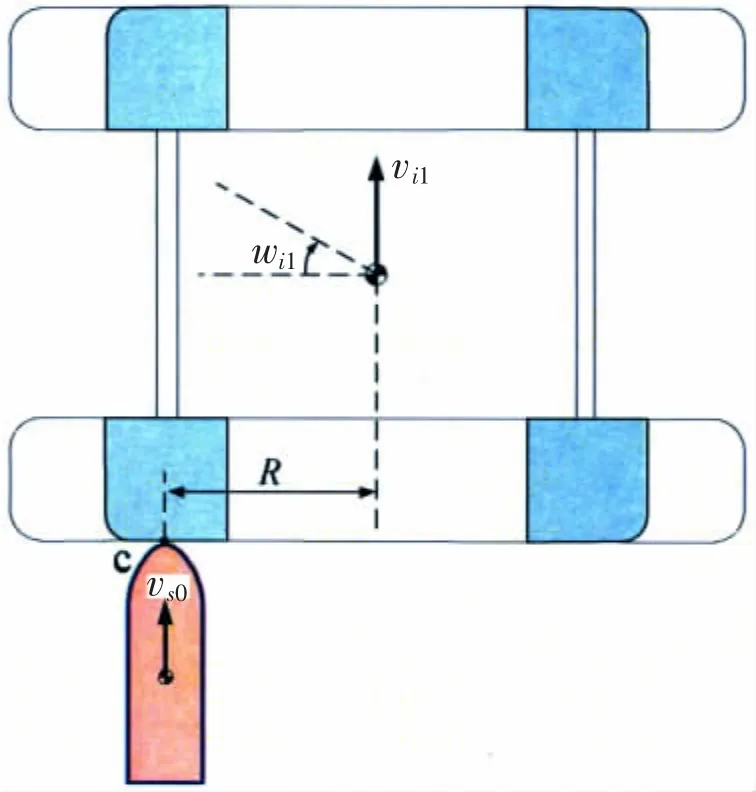
Fig.1 A collision scenario with an offset between a striking ship and a semi-submersible drilling platform
With the semi-submersible drilling platform for the collision object,the platform column is the impact site.Assuming that the ship-platform collision is entirely plastic collision,and the struck platform is unconstrained before the collision,considering that the speed of the platform before the collision is vi0=0 and the yawing motion response to platform,we develop a new analytical method for estimating dissipated energy.A collision scenario with an offset between a striking ship and a semi-submersible platform is shown in Fig.1.
Assume the mass of a striking ship is Ms,the ship sails at a forward speed of vs0,the added mass coefficient is ms,and the velocity at the end of the collision is vs1.The mass of the struck platform is Mi,the added mass coefficient is mi,the velocity in the COG of the platform at the end of the collision is vi1,and the final angular velocity is wi1.The vertical distance between the direction of the impact and the COG of the platform is R,the moment of inertia of semi-submersible drilling platform around its COG including added inertia is Ji,and the radius of gyration of semi-submersible drilling platform is ρi,i.e.,As the collision duration is short,and the collision force is very large,so all other external forces are neglected,the momentum of the collision system is conserved during the collision.This leads to the two following equations:

At the critical state of the end of the collision,assuming that the striking ship and the platform reach a common speed,that is:

According to Eq.(3),Eqs.(4)and(5),we can solve the speed at the end of the platform impact:


Similarly,the speed of the striking ship at the end of the collision can be solved:

On the basis of the conservation of energy,the dissipation energy of the impact ship at the end of collision is:

By substituting Eq.(5),Eq.(7)and Eq.(8)into Eq.(9),we can obtain:

Note that the expression of the moment of inertia of platform,i.e.,with the def-inition of p and q,we can obtaincan be expressed as:

It can be seen from the Eq.(11)that the energy dissipated by the impact vessel can be quickly estimated if the ratio of the impact ship and the platform,p,the vertical distance between the impact direction and the center of gravity of the platform,R,and the radius of the platform ρiare known.
In order to facilitate the comparison with the following examples,the method of estimating dissipative energy of Eq.(2)is denoted as DNV method,and Eq.(11),the new formulation since the eccentricity R is taken into account,is named DNV`R method.It can be seen from the two formulas that the formulas of the two methods have certain similarity,i.e.,when the eccentricity is 0,the Eq.(11)can be reduced to Eq.(2).
3 Principal dimensions and the FE model of platform and OSV
Due to the lack of the calculation examples of the dissipated energy of the ship platform collision and the relevant experimental data,in this paper,the striking ship is chosen as the supply vessel,and the struck platform is a semi-submersible drilling platform.The nonlinear finite element analysis(NLFEA)method is adopted based on MSC.DYTRAN nonlinear analysis software,so as to realize the virtual collision test between OSV and selected platform,and the calculated results are used as a reference object of the estimation results of each analytic method.
3.1 Principal dimensions of platform and OSV
The semi-submersible drilling platform is 3 000 m of operating depth,whose principal dimensions are as shown in Tab.1.The selected striking ship is an ocean supply ship(OSV)that is the main service vessel of the platform.The principal dimensions of the OSV are presented in Tab.2.

Tab.1 Principal dimensions of semi-submersible drilling platform

Tab.2 Principal dimensions of OSV
3.2 Collision scenarios between OSV and platform
There are three conditions of ship collision platform,i.e.,bow impact,stern impact and side impact.According to the data statistics of IACS about collision accidents between supply ships and platforms in the past,we can find that the probability of stern impact is 70%,theside impact 20%,and the bow impact very unlikely.Considering the characteristics of the selected OSV whose accommodation space is located at the bow and with a big deck for cargo laid out at the stern,the berthing way of OSV is mainly stern toward the target platform.From an integrative consideration,it is reasonable and necessary to choose the stern impact as the main type of collision.When OSV is berthing stern to target platform,the possible impact position of the supply ship on the work platform is the straight wall or the transition surface of the column,as shown in Fig.2.

3.3 The FE model of platform and OSV
The FE model of semi-submersible drilling platform and OSV is shown in Fig.3.The element size of the collision zone is generally 160 mm.For large offshore structures in full-scale collision simulations,the mesh size can accurately simulate the damage and deformation of structures and capture the strain energy absorption values of the plastic deformation structure[17].At the meantime,for the structures that far from the collision zone,larger elements are adopted not only to accurately simulate the impact of the inertia of the OSV and a semi-submersible drilling platform in the process of the collision,but to reduce modeling and calculation costs.

Fig.3 The FE model of platform and OSV
3.4 Main parameter setting in numerical simulation of ship-platform collision
To be as close as possible to the actual collision scene,all of the structures of the striking ship and platform are made of the elastic-plastic material,which is ElasPlas(DAMTEP24)in the DYTRAN code.The OSV uses low-carbon steel material parameters,whose parameters of strain rate are obtained by D=40.4/s and q=5;correspondingly,high strength steel material parameter is adopted in the platform and the parameters of strain rate are obtained by D=4 000/s and q=5[18].Moreover,the failure strain of these two materials are set to equal to εf=0.15.
The collision process of ship-platform involves the dynamic contact problem.The key technique of solving is to deal with the contact algorithms of different structure interface.Penalty-based contact algorithms are used to simulate the contact between the striking ship and the column of the platform and the internal of either the ship or the platform.Besides,the static and dynamic friction coefficients of 0.3 are used in all of the contact formulations[19].Furthermore,when the platform is in operation,it is a typical floating platform[16].Therefore,in numerical simulation,the struck platform is free of any boundary conditions,so that it is in a fully free state,in order to make numerical simulation closer to the actual collision scenario.
4 Numerical examples
In this paper,when the analytical method is analyzed,Zhang’s analytic method and Liu’s analytic method in the ship collision dissipation energy estimation are applied to the ship-platform collision scene.The results are compared with those of the DNV`R analytic method and the new formulation proposed in this paper.In other words,DNV,DNV`R,Zhang,Liu`2D and Liu`3D dissipative energy analysis are used to analyze the cases in the following numerical examples.On using the Liu`2D method,it is assumed that the vertical position of the collision point is 0,i.e.,Zsc=Zic′=0.In addition,taking into account the complexity of the computation process on using Zhang’s method and Liu’s methods,we will work out programs to realize the dissipation energy of ship-platform collision scenarios respectively.Finally,the results of nonlinear finite element numerical simulation of ship-platform collision are compared as a reference with those of the analytical methods.
On calculating by the analytic method,the coefficient of restitution is assumed to e=0,i.e.,that the ship-platform collision is entirely plastic collision.And taking into account the interaction effects between the striking ship and the struck platform and the surrounding water,the additional water mass method is adopted,and the added mass coefficients obtained are shown in Tab.3.The radius of gyration of them can be determined by empirical formula,as presented in Tab.4.In the table,Liis the length of the lower hull of the platform,Biis the width of the outer side of the two lower hulls,and Lsand Bsare the length and the width of the supply ship respectively.

Tab.3 Hydrodynamic coefficients
4.1 The supply vessel collision with the semi-submersible platform along the Y′direction
The supply vessel has the same impact position,and the impact velocity is chosen from 0.5 m/s to 10 m/s.At the end of the collision,the total strain energy absorbed by the structure is the calculation result of Nonlinear Finite Element Analysis(NLFEA)when the impact force is decreased to 0.Meanwhile,according to the parameters such as mass ratio p,eccentricity R and impact velocity of the ship and the platform,the dissipated energy is estimated by different analytic methods.The results are shown in Tab.5.

Tab.4 The radius of gyration

Tab.5 The dissipated energy of different impact velocity at the same impact position
From Tab.5,the coefficient of energy dissipation ηdisipt,and relative error of each calculation method can be obtained,ηdisiptis defined as follows:

where Edisiptis the dissipated energy of OSV,Ekis the initial kinetic energy of the OSV.
And the relative error of analytic method,Error,is defined as:

where EAnalyticalMethodis the dissipated energy estimated by the analytic method,ENLFEAis the strain energy calculated by NLFEA.
Fig.4 is a graph showing the coefficient of energy dissipation of each calculation result obtained by Eq.(12),and Fig.5 is a graph showing the relative errors of various analytical methods with the impact velocity based on Eq.(13).

Fig.4 The coefficient curve of energy dissipation and impact velocity relationship

Fig.5 The relative errors of various analytical methods for impact velocity
From Tab.5 and Fig.4,it is clear that the dissipation energy results calculated by each analytical method are larger than those obtained by NLFEA.This is mainly due to the fact that on using NLFEA,the partial of the initial kinetic energy of the striking ship is transformed into the hourglass energy of the shell element and the friction energy,so the strain energy dissipation transformed by kinetic energy of the ship is relatively small.
It can be seen from Fig.5,compared to NLFEA strain energy,that DNV results have greater errors,and the relative error is enlarging gradually with the increase of the impact velocity.Specifically,the error is increased from about 14%when the impact velocity is 0.5 m/s to about 22%when the velocity is 10 m/s,thus,the dissipative energy results of DNV estimation are relatively conservative.In addition,the main difference between Zhang and Liu`2D is the coordinate system when the position parameter is input.When the vertical height of the impact point is neglected,the calculated results are consistent with NLFEA results given by MSC.DYTRAN.The results show that it is feasible to apply Zhang’s method and Liu’s method to estimate the dissipation energy of the ship-platform collision.More importantly,the calculation results of DNV`R method developed in this paper are very close to those of NLFEA,and to those calculated by Zhang’s method and Liu’s method.In particular,for the same impact position,the smaller the impact speed is,the more accurate the estimated result of energy is,and the maximum relative error is only 8.2%when the impact speed is 10 m/s.
4.2 The supply vessel impacts the semi-submersible platform with different impact angles
In the actual collision accident,the impact direction of the supply ship impact platform has certain randomness due to human factors and sea conditions and many other uncertainties,so it is necessary to consider the collision scenarios of the ship’s stern at different angles against the semi-submersible column.The analysis shows that due to the particularity of the outer surface of the platform column,each impact point is perpendicular to the longitudinal direction of the supply ship in the tangential direction of the collision plane,i.e.,the waterline angles α,are 90°.In order to analyze the impact of different impact angles θ,on the calculation results,the 4 m/s impact velocity and the same height over the COG of the platform are analyzed.A schematic diagram of the supply vessel against the platform column with different impact angles,for simplicity the longitudinal direction of the supply vessel is indicated by the longitudinal profile of the striking ship,is shown in Fig.6.
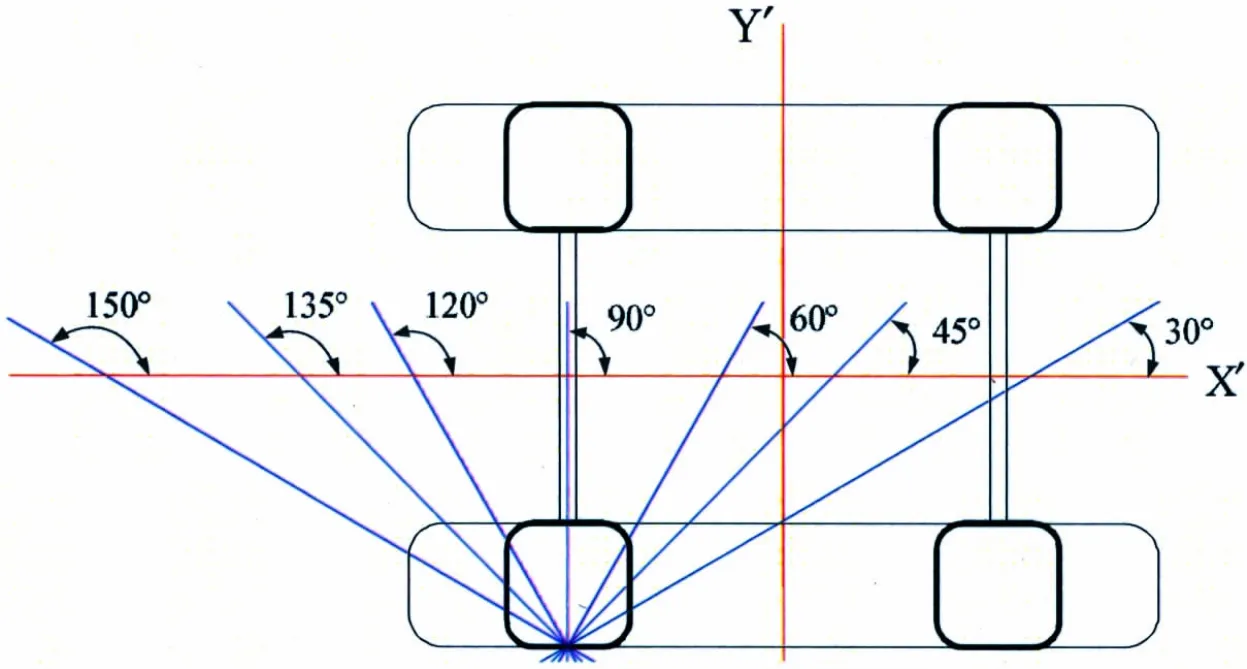
With the collision parameters of different impact angles,the dissipation energy of the supply ship can be obtained by the analytic methods(the initial impact kinetic energy of the supply vessel is 44MJ),and the calculation results of energy dissipation corresponding to impact angles are shown in Tab.6.

Tab.6 The calculation results of dissipation energy of supply vessel
According to Eq.(12)and Eq.(13),it can be calculated for each calculation of the dissipation energy coefficient curve and the relative error with the impact velocity curve respectively,as shown in Fig.7 and Fig.8.

Fig.7 The coefficient curve of energy dissipation and impact angle relationship
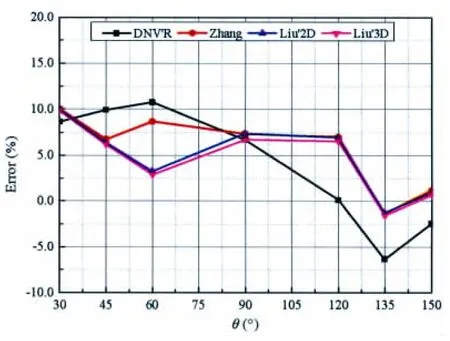
Fig.8 The relative errors of various analytical methods for impact angle
It can be seen from Fig.7 that the dissipation energy coefficient of each method is decreasing as the impact angle increases at the same impact velocity,indicating that the supply ship dissipative energy is declining,and the ship-platform motion response is increasing with the impact angle increasing.Besides,as we can see from Fig.8,the results of analytical methods have some deviations compared with numerical simulation.This kind of error is mainly caused by the existence of hourglass and other damping in numerical simulation,which is unavoidable.And we can find that the results obtained by Liu`2D and Liu`3D are very similar,indicating that the height of the collision is not significant for the roll motion of the platform.Finally,it is important to know that by comparing the relative error of each analytic method,it can be seen that the error of DNV`R method is basically close to that of Zhang’s method and Liu’s method.
4.3 The supply vessel impacts the semi-submersible platform column transition at different angles
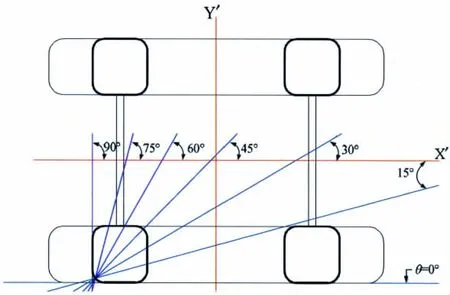
Fig.9 The supply vessel impacts the platform in the transition direction with different impact angles
The supply of the ship stern may also impact the platform column transition,supply ship stern impact point corresponding to the platform transition for the cylindrical straight wall,the corresponding water angle is 90°,the collision scene is shown in Fig.9.
Similar to Section 4.2,take different impact angle,4 m/s impact speed and the same impact height for calculation and analysis respectively.With inputting the collision parameters of each impact angle,the dissipation energy of the supply ship can be obtained by each analytic method,see Tab.7.

Tab.7 The dissipated energy of OSV impacting the platform along the column transition
According to the Eq.(12)and Eq.(13),it can also be calculated for each calculation result of the dissipation energy coefficient curve and the relative error with the impact velocity curve respectively,as shown in Fig.10 and Fig.11.
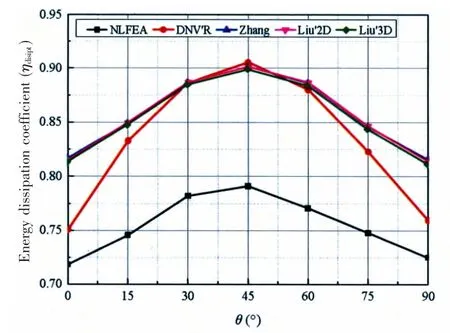
Fig.10 The coefficient curve of energy dissipation and impact angle relationship

Fig.11 The relative errors of various analytical methods for impact angle
It can be seen from Fig.10 that when the impact angle is about 45°,the dissipation energy coefficients obtained by each method are larger,indicating that the energy dissipation of the supply vessel is more and the ship-platform movement response is relatively small.When the impact angle is larger than 45°,the greater the vertical distance of the ship impact direction and the center of gravity of the platform,the greater the motion response to the platform after the collision,and correspondingly,the dissipation coefficient decreases in Fig.10.From the relative errors of various analytical methods for impact angle in Fig.11,and we can also find that the results obtained by Zhang’s method,Liu`2D and Liu`3D are very similar,indicating that the height of the collision is not significant for the roll motion of the platform.On the other hand,we can find that the relative error of Zhang’s method,Liu`2D and Liu`3D is relatively stable,basically between 12%and 15%.Last but not least,the DNV`R method,the maximum error is about 14%when the impact angle is about 45°;when the impact angle is 0°or 90°,DNV`R’s estimation results are very close to the results of NLFEA,and the minimum error is only about 4%.
5 Conclusions
Based on DNV specification calculation method,a new analytic method for estimating the dissipated energy of OSV impacting the platform was developed,called DNV`R analytical method.Moreover,we applied Zhang’s method and Liu’s method in the ship collision dissipation energy estimation to the ship-platform collision scene,and worked out programs to realize the dissipation energy of ship platform collision scenarios respectively.Based on the numerical simulation results of NLFEA of ship-platform collision,the results of each analytical method were compared and analyzed.The conclusions are drawn as follows:
(1)The dissipative energy estimation method proposed by DNV,the specification method,is relatively conservative,and only applicable for central impact.For collision with an offset,the calculation error of the DNV method is more obvious,so the range of application has a larger limitation.Compared with the NLFEA strain energy results,it can be found that the DNV`R method proposed in this paper is suitable for the collision with an offset,and especially suitable for the collision scene of the ocean structure with small response to rolling and pitching motion.
(2)From the calculation results of the dissipated energy of the striking ship with different impact velocities and different impact angles,it can be found that:the relative errors of various analytical methods are below 15%,except for the DNV dissipation energy estimation method.When estimating the dissipated energy of the striking ship in such collision scenarios,we can use the DNV`R method proposed in this paper or the program based on Zhang’s method and Liu’s method to make a fast estimation.
(3)In general,the accuracy of the DNV`R method proposed in this paper is close to that of Zhang’s method and Liu’s method,which meets the accuracy requirements of fast estimation of ship-platform collision dissipation energy.As DNV`R’s analytic form is simple and the process of calculating is convenient,it can be used to estimate the dissipated energy of given collision scenarios quickly,so as to provide some reference for the design of the collision structure of marine structures such as semi-submersible drilling platforms.
[1]Wang Z,Gu Y.Motion lag of struck ship in collision[J].Shipbuilding of China,2001,42(2):56-62.(in Chinese)
[2]Minorsky V U.An analysis of ship collision to protection of nuclear powered plant[J].J Ship Rsearch,1959(1):1-4.
[3]Petersen M J.Dynamics of ship collisions[J].Ocean Engineering,1982,9(4):295-329.
[4]Woisin G.Instantaneous loss of energy with unsymmetrical ship collisions[J].Schiff&Hafen,1988,40(1):50-55.
[5]Zhang S.The mechanics of ship collisions[D].Denmark:Technical University of Denmark,1999.
[6]Stronge W J.Impact mechanics[M].Cambridge:Cambridge University Press,2004.
[7]Liu Z,Amdahl J.A new formulation of the impact mechanics of ship collisions and its application to a ship-iceberg collision[J].Marine Structures,2010,23(3):360-384.
[8]Liu J,Hu Z.3D analytical method for the external dynamics of ship collisions and investigation of the coefficient of restitution[J].Chinese Journal of Ship Research,2017,12(2):84-91.(in Chinese)
[9]Mcdermott J,Kline R,Jones E,et al.Tanker structural analysis for minor collisions[J].Deformation,1974.
[10]Sabril Haris,Jorgen Amdahl.An analytical model to assess a ship side during a collision[J].Ships and Offshore Structures,2012,7(4):431-448.
[11]Gao Z,Hu Z,Wang G.A simplified analytical method for prediction of anti-collision capability of FPSO side structures[J].Engineering Mechanics,2014,31(s1):155-160.(in Chinese)
[12]Liu B,Villavicencio R,Soares C G.Simplified analytical method to evaluate tanker side panels during minor collision incidents[J].International Journal of Impact Engineering,2015,78(78):20-33.
[13]Liu B,Soares C G.Analytical method to determine the crushing behavior of girders with stiffened web[J].International Journal of Impact Engineering,2016,93:49-61.
[14]Liu K,Wang Z,Zhang Y,et al.Collision behavior of structural analysis in ship collisions based on full-coupling technology[J].Journal of Ship Mechanics,2015,19(5):574-581.(in Chinese)
[15]Yu Z,Amdahl J,Storheim M.A new approach for coupling external dynamics and internal mechanics in ship collisions[J].Marine Structures,2016,45:110-132.
[16]DNV-RP-C204.Design against accidental loads[S].2010.
[17]Kõrgesaar M,Romanoff J.Influence of mesh size,stress triaxiality and damage induced softening on ductile fracture of large-scale shell structures[J].Marine Structures,2014,38(5):1-17.
[18]DNV-RP-208.Determination of structural capacity by non-linear FE analysis methods[S].2013.
[19]Hogström P,Ringsberg J W.Assessment of the crashworthiness of a selection of innovative ship structures[J].Ocean Engineering,2013,59(59):58-72.
一种新的碰撞耗散能快速估算方法及其在船—平台碰撞事故中的应用研究
谷家扬1,邓炳林1,陶延武1,王 璞2,周 佳2
(1.江苏科技大学 海洋装备研究院,江苏 镇江212003;2.中国船舶及海洋工程设计研究院,上海 200011)
海洋平台在作业过程中存在遭受船舶碰撞的潜在危险,一旦事故发生将可能导致结构严重损伤从而影响平台的作业安全,因此在平台结构设计阶段需要考虑其抗撞性能。文章以海洋供应船撞击半潜式钻井平台为研究对象,基于碰撞外部动力学理论和DNV规范计算方法,计及平台艏摇运动响应的影响,提出了一种新的耗散能估算方法-DNV`R解析法。以非线性有限元船-平台碰撞数值仿真结果为参考,将该解析法与规范法、Zhang解析法及Liu解析法计算结果进行对比,研究得出:文中所提出的DNV`R解析法弥补了规范法较为保守且仅适用于对心碰撞场景的不足,计算过程简单、便捷,且计算精度与Zhang解析法和Liu解析法基本接近,能够满足船-平台碰撞耗散能快速估算的精度要求。
船—平台碰撞;耗散能;解析法;碰撞外部动力学
U661.1 U674.38+1
A
谷家扬(1979-),男,博士,江苏科技大学副教授,通讯作者,E-mail:gujayang@126.com;
邓炳林(1990-),男,江苏科技大学硕士研究生;
陶延武(1990-),男,硕士,江苏科技大学海洋装备研究院,工程师;
王 璞(1977-),男,硕士,中国船舶及海洋工程设计研究院,研究员;
周 佳(1981-),男,博士,中国船舶及海洋工程设计研究院,高级工程师。
U661.1 U674.38+1
A
10.3969/j.issn.1007-7294.2017.12.011
date:2017-09-21
Supported by Special Project for innovation for‘Seventh generation ultra-deepwater drilling platform(ship)’of high-tech ship of Ministry of Industry and Information Technology;Special Project for innovation for‘Research and development of deepwater semi-submersible support platform’ of hightech ship Ministry of Industry and Information Technology;the National Natural Science Foundation of China(51779109);Natural Science Foundation of Jiangsu,China(BK20171306);the State Key Laboratory of Ocean Engineering of Opening Foundation(1407)
Biography:GU Jia-yang(1979-),male,Ph.D.,associate professor,corresponding author,E-mail:gujiayang@126.com;DENG Bing-lin(1990-),male,master student.
1007-7294(2017)12-1564-14
- 船舶力学的其它文章
- Low-Cycle Fatigue Crack-Propagation Behavior for Ship Cracked Plate Considering Accumulative Plastic Damage
- Numerical Simulation of Deterministic Freak Wave Based on Energy Distribution
- Method of Estimating the Effect of Marine Fouling on Frictional Resistance of Ships
- Evaluation of Viscous Effect on Wave Excitation Force of a Vessel with Transom Stern
- Numerical Predictions of the PPTC Propeller Tip Vortex Cavitation in Uniform Flow
- Enhanced Extinction Curve Method for Roll Damping Estimation

